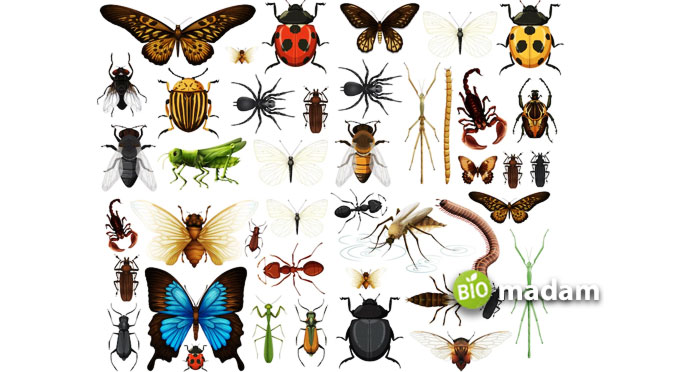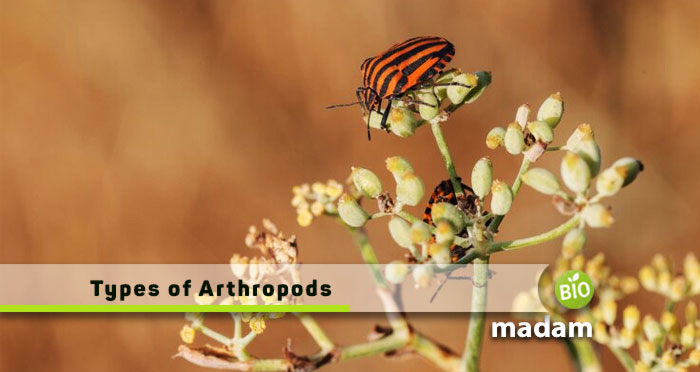Recently updated on June 16th, 2023 at 08:23 am
Arthropods are an important part of our community and ecosystem. They are small in size but not microscopic, unlike bacteria and viruses. Arthropods are spread everywhere, insects being the most common members of this phylum. They are involved in pollination fertilization to help plants reproduce. Arthropods also contribute to the decomposition process.
Keep reading to learn everything about arthropods, including the types of arthropods.
What are Arthropods?
Arthropods are members of the phylum Arthropoda. The name ‘Arthropoda’ originates from the Greek words ‘arthros’ and ‘pods,’ meaning jointed and foot, respectively.
Arthropods are invertebrate organisms having multiple joints, segmentation, a chitinous exoskeleton, and an open circulatory system.
So, if an organism has an exoskeleton and the body and feet have joints, it is an Arthropoda.
There are over 30 million species in Phylum Arthropoda. The class Insecta makes a huge fraction of this phylum and can survive in all habitats and ecosystems.
Arthropods develop their exoskeleton from the hard cuticle covering present between the body segment and limbs. The cuticle is connected to the muscles, enabling flexibility in movement.
Furthermore, their segmented bodies are bilaterally symmetric with a different number of segments in their body. The number of segments depends on their origin and function.
Researchers discovered arthropods millions of years ago. Their history dates back to around 550 million years ago with the discovery of the dominant arthropod trilobites. Later, arachnids were found 400 million years ago, and insects appeared around 350 million years ago.
Let’s tell you about the general characteristics of Arthropods before we talk about different types of Arthropods.
Characteristics of Arthropods
- They are multicellular organisms comprising eukaryotic cells
- The bodies of Arthropods are segmented, triploblastic, and bilaterally symmetrical
- Their exoskeletons comprise chitin
- Arthropods have organ system-level organization
- Their limbs are joined, which facilitate movement
- The body is segmented into the head, thorax, and abdomen
- Their circulatory system is an open circulatory system with blood and plasma in the coelomic cavity
- They have a well-developed digestive system
- The nervous system is “ventral,” which means it is present along the front of their bodies
- Arthropods exhibit internal and external fertilization
- Respiration in Arthropoda takes place through thetrachea or body surface
- They have a well-developed sensory system comprising hairs, auditory organs, antennae, eyes, and statocysts
Types of Arthropods
The types of arthropods are categorized into four subphyla, including Crustacea, Chelicerata, Hexapoda, and Myriapoda. Crustacea comprises lobsters, prawns, shrimps, and crabs, whereas Chelicerata has spiders, scorpions, and ticks. Hexapoda and Myriapoda consist of insects and centipedes, respectively. Besides the four subphyla of Arthropods found in different types of biodiversities, Trilobitomorpha is an extinct ancient family of marine arthropods.

Trilobitomorpha
Trilobitomorpha is an ancient family of arthropods that lived in marine areas. They belonged to ecological niches occupied by crustaceans today. They had three-lobed bodies divided into three segments. Two of the lobes lay on each side of the longitudinal axial lobe.
They first appeared around 542 million years ago and became less abundant over time. Trilobites went extinct almost 251 million years ago at the end of the Permian mass extinction that killed over 90% of all Earth species.
Characteristics of Trilobitomorpha
- Their body was divided into head, thorax, and pygidium
- They contained lobes including one median and two lateral lobes
- No structural differentiation of body parts was present
- Trilobites had a pair of compound eyes and antennae
- The appendages in these organisms were biramous
Classes of Trilobitomorpha
Trilobitomorpha had only one class called Trilobita.
Examples of Trilobitomorpha
Asaphus, Asaphida, Paradoxides, and Proetida are believed to belong to Trilobitomorpha.
Crustaceans
Crustaceans are aquatic arthropods, including shrimps, crabs, barnacles, and crayfish. Adult barnacles produce hard shells that help them stick to underwater surfaces and the bottom of boats.
Woodlice also belong to crustaceans but do not live in water. They live on dry land, are surplus in forests and gardens, and help decompose like fungi and molds.
Characteristics of Crustaceans
- A large carapace covers the body of crustaceans
- The animals are terrestrial, aquatic, or parasitic
- The head and thorax region fuse at the cephalothorax
- They have five pairs of limbs and two pairs of antennae
- Crustaceans have gonopores and a pair of compound eyes
- They excrete through antennal glands
Classes of Crustaceans
Crustaceans are further categorized into six classes, including:
- Chephlocarida
- Ostracoda
- Branchiopoda
- Maxillopoda
- Remipedia
- Malacostraca
Examples of Crustaceans
Examples of Crustaceans include true crabs, lobsters, krill, and barnacles.
Chelicerates
Chelicerates comprise different kinds of organisms that do not look quite similar to each other. They include arachnids, sea spiders, and horseshoe crabs. Arachnids are spiders and scorpions, whereas sea spiders have a few distinct features.
Characteristics of Chelicerates
- They typically live on land
- Their body has 13 segments
- Chelicerates contain cephalothorax and abdominal regions.
- They have four pairs of limbs
- Antennae are absent in Chelicerates
- Respiration takes place through the gills
- They excrete through the Malpighian tubules
Classes of Chelicerates
The sub-phylum Chelicerata is divided into three further classes:
- Arachnida
- Merostomata
- Pycnogonida
Examples of Chelicerates
Horseshoe crabs, ticks, scorpions, and sea spiders are examples of Chelicerates.

Hexapods
The term ‘Hexapoda’ comprises ‘Hexa,’ meaning six, and ‘pods,’ meaning feet. Thus, arthropods with six feet or limbs are called hexapods.
Hexapods are abundant around us, including ants, beetles, cockroaches, mosquitoes, flies, etc. Collembola, Protura, and Diplura are also a part of Hexapoda.
Characteristics of Hexapods
- Hexapods are terrestrial organisms
- They have three pairs of appendages
- Their body is segmented into the head, thorax, and abdomen
- The thorax is divided into three more segments
- Hexapoda abdomen has seven to eleven segments
- Respiration takes place through the gills and trachea
- They have a pair of compound eyes
- Malpighian tubules help with excretion
Classes of Hexapods
The subphylum Hexapoda is divided into two classes according to their characteristics.
- Insecta
- Entognatha
Examples of Hexapods
Examples of hexapods include bees, butterflies, Protura, and insects.
Myriapods
The term Myriapods translates to ‘many legs.’ Thus, the subphylum Myriapoda comprises organisms with many legs, like centipedes and millipedes. They may have ten to over 750 legs.
While you might not typically see Myriapods with over a hundred legs, they exist!
Myriapods are present in all biomes and ecosystems that offer surplus decaying animal and plant matter for them to feed on.
Characteristics of Myriapods
- Like other arthropods, they are also mostly terrestrial
- They may have around ten or as many as 750 legs
- The elongated Myriapodal body has multiple segments
- They have two pairs of jaws, and the head contains antennae
- Their mouth has a pair of mandibles
- Myriapods respire through the trachea
- Excretion takes place by Malpighian tubules
Classes of Myriapods
The subphylum Myriapods have the following classes
- Chilopoda
- Diplopoda
- Pauropoda
- Symphyla
Examples of Myriapods
The most common organisms belonging to Myriapods include centipedes and millipedes.
Facts About Arthropods
- Arthropods, the invertebrates, have existed for over 100 million years before vertebrates.
- They make up around 80% of all animal species on Earth.
- The exoskeleton of arthropods is composed of chitin.
- Arthropods have segmented bodies. Different subphyla vary in the number of segments in the body.
- Arthropods undergo ecdysis once in their lifetime. It refers to the molting of shells to build a new shell.
- Most classes of arthropods have compound eyes.
- Crustaceans and arachnids have blue blood instead of red.
- Many species of the arthropod genus lay eggs.
- All arthropods experience metamorphosis.
- Arthropods are an essential part of the food chain and food webs.

The Bottom Line
Arthropods belong to Phylum Arthropoda and makeup around 80% of the total animal species and subspecies on Earth. They are further divided into four subphyla and are classified based on their anatomy and physiology. The segments of Arthropod bodies contribute to their categorization into different classes. Most Arthropods live on terrestrial surfaces compared to ancient marine Arthropods. They play a major role in decomposing animals, plants, and algae.
FAQs
What is the most common type of arthropod?
Some common types of arthropods include insects, crabs, fish, crayfish, lice, and horseshoe shrimp. Some of these niches live in aquatic habitats, while most survive on dry land.
How many species are arthropods?
Arthropods comprise 80% of the total animal species on Earth. There are over 30 million species of arthropods contributing to parasitic and decomposition functions.
What is the largest arthropod group?
Insects are the largest groups of arthropods with three body segments: head, thorax, and abdomen. They have three pairs of jointed legs, one pair of antennae, segmented bodies, one or two pairs of wings, and an exoskeleton.

Anna has completed her degree in Pharmacy from the University of Hawaii. She is serving as a research assistant in a pharmaceutical company. She had a great interest in writing blogs, traveling to different parts of the US, and trying delicious recipes in her spare time.

